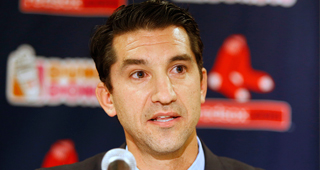The first blockbuster trade of the offseason went down right when folks were getting ready to dream of turkey late on the eve of Thanksgiving, as the Mariners and Diamondbacks switched out a bushel of players and gave us our first hint of how new Arizona GM Mike Hazen is going to revamp his roster. Both of these teams fall squarely into the category of teams with some great pieces to build around, but have repeatedly failed in recent years to figure out how to put it all together. The trade which sent middle infielder Jean Segura, outfielder Mitch Haniger and LHP prospect Zac Curtis to Seattle and sent starter Taijuan Walker and shortstop Ketel Marte to Arizona is definitely the most interesting trade to happen in this young offseason, so let’s get things started looking at what went Seattle’s direction.
Segura had a mammoth year for Arizona in 2016, hitting /319/.368/.499, good for a 124 OPS+, 5.7 bWAR/5.0 fWAR and some NL MVP votes. One of the elephants that’s hanging out in the room is the fact that over his prior two seasons he hit .252/.285/.331, which put his OPS+ at 69. That elephant is not alone, though, as Segura’s BABIP on the season was .353, while his BABIP from 2012 to 2015 was .301. To be fair to Segura, he maintained that BABIP over a full season and it was definitely buoyed by a massive power spike (his hard-hit percentage in 2016 was 29.7%, compared to 20.4% over the prior two seasons). While this wasn’t Segura’s first season putting up solid numbers, as his 4.0 bWAR/3.5 fWAR 2013 shows that it might not have been a total fluke, you can understand Arizona’s decision to sell high on Segura right now.
Haniger just finished his rookie season in Arizona, batting only .229/.309/404 for a 85 OPS+ while grading out average to slightly-positive defensively. Those numbers aren’t flashy, but he was one of Arizona’s top prospects and had hit .321/.419/.521 between Double-A and Triple-A. Seattle is obviously hoping that he’s able to hit a little more and develop into something better than a fourth outfielder as he gets more seasoning against big league pitching.
The last piece that went to Seattle was Curtis, who made the jump straight from Double-A to the majors this season, thanks to some gaudy strike out numbers in the minors. His first cup of coffee wasn’t so sweet (6.75 ERA and 7.20 FIP, with a huge dip in strikeouts and jump in walks), but he still has potential to stick around as a bullpen arm if he’s able to adjust to MLB-quality hitters.
On Arizona’s end, the biggest get was Walker, who is a former top-10 prospect who hasn’t quite been able to put it all together over a full season. While he can reach almost 100 MPH on his fastball, he’s had command issues combined with recurring injuries which haven’t allowed him to get anywhere near the ace potential that folks saw as he pitched in the minors. His 2016 season was arguably his worst to date, as he showed a new found propensity for giving up the longball and ended up with a 4.22 ERA and 4.99 FIP. That being said, the stuff is still there, so you can’t blame Arizona for taking a chance on him. While his floor appears to be that of a back-end starter, he still has an ace ceiling, after all, and that’s something worth taking a chance on if you need pitching help, as Arizona does.
The last piece in the trade was Marte, who took a serious step back from his short 2015 season (.283/.351/.402, 112 OPS+ over 247 PA) and hit .259/.287/.323 over 466 PA for a 68 OPS+ in Seattle this year. While Marte isn’t a superstar defensively, if he’s able to hit more like he did in 2015 than 2016, he could certainly be an everyday player at shortstop. The fact that’s he’s only 22 certainly contributes to his allure on Arizona’s part.
On that that last note, there were some contract status issues that were under consideration in the swap as well. Walker is hitting arbitration for the first year this season (and will have Super 2 status) and will be a free agent in after the 2020 season. Segura will be a free agent after the 2018 season. Marte is four years younger than Segura and is controllable through 2021.
Grade for Diamondbacks: B
While we weren’t entirely sure how Arizona’s new GM was going to approach this offseason, we know he’s not throwing in the towel for a rebuild, despite the lackluster results of last season. With a need to shore up their starting pitching (Arizona had the 3rd worst ERA in MLB in 2016) and that market being profoundly depressing this offseason, this looks like a solid move on Arizona’s part since they dealt from a position of strength (their a glut of infielders, which was reinforced by the addition of Marte). They also got younger and possibly sold high on Segura. While there are certainly question marks, there’s a lot to like here as well.
Grade for Mariners: B
The Mariners’ side of the ledger sheet isn’t without questions either. Obviously, they’re gambling on Segura’s breakout being for real. Whether Haniger ends up being able to be an everyday contributor (and Dave Cameron of Fangraphs thinks it’s quite possible) is also a big question. But, like Arizona, Seattle dealt from a position of relative strength and addressed a need, as shortstop was a wasteland last season. As always, we’ll have to wait and see how the cookies crumble before we can declare this trade a success for either team, but this looks like a relatively smart move in both directions that, while not without risks, could even end up working out well on both ends.



